#born 15th april 1938
Text
HAPPY BIRTHDAY CLAUDIA CARDINALE!
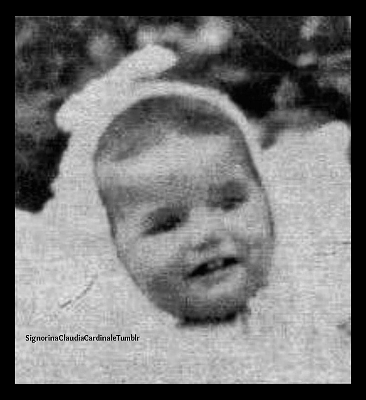
On this day, April 15, 1938, Claude Josephine Rose Cardinale Greco was born in Tunisia, she is one of the great divas of European cinema and today she turns 86 years old.

Claudia blows out the candles on her birthday cake during her 21st birthday celebrations, April 15th 1959.
📷Photo by Evening Standard
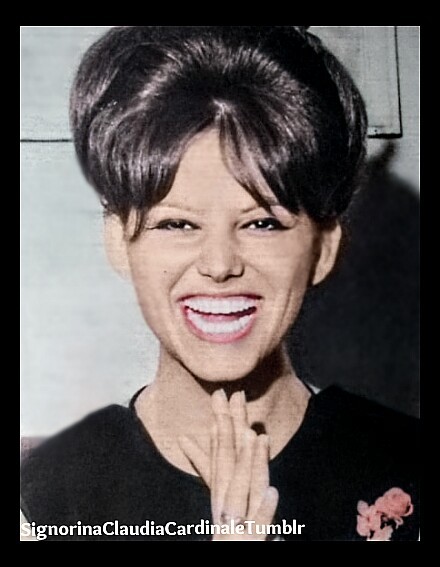
Claudia on her 23rd birthday in 1961 with her brothers Bruno, Adrien and sister Blanche.
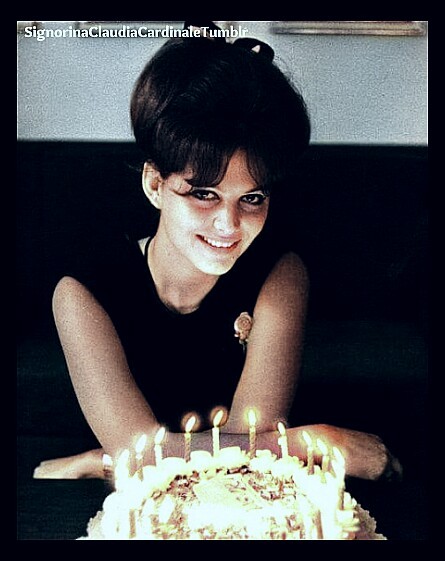


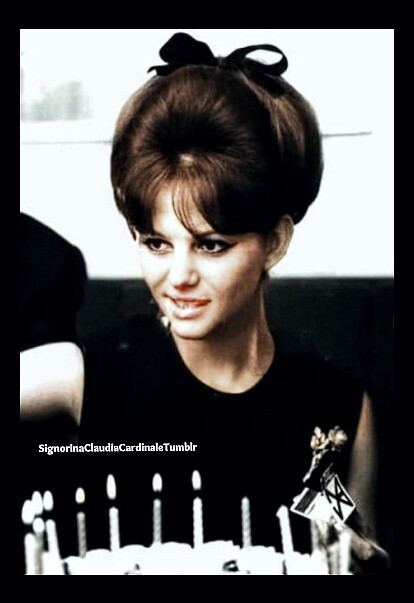
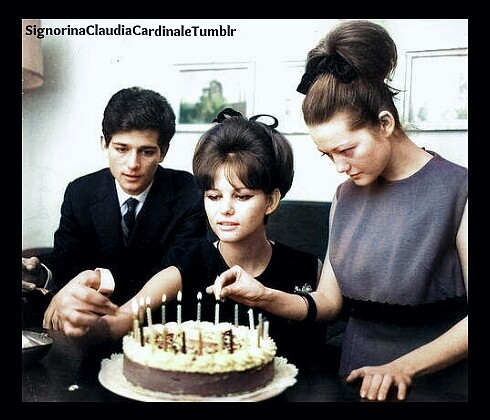
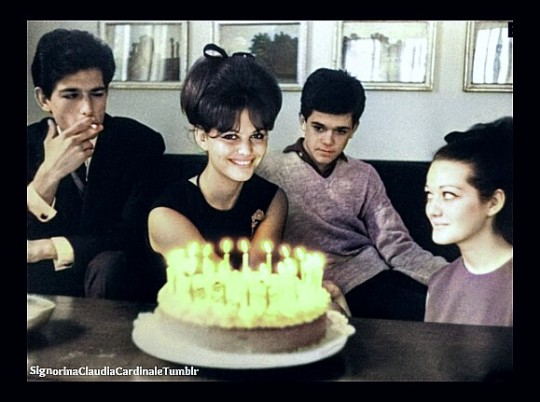


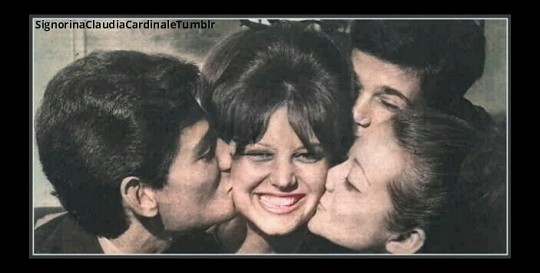
Claudia on her 26th birthday in 1964 with her sister Blanche.

Buon compleanno and Tanti Auguri mi diva Claudia Cardinale!!!!!
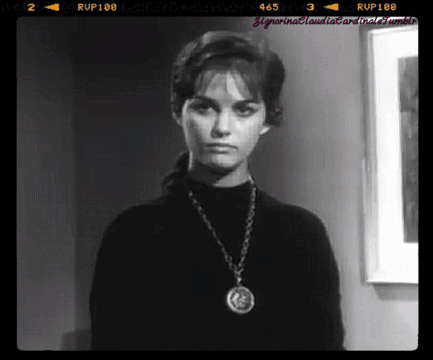


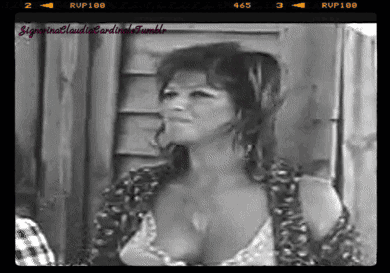

"As a child I dreamed of being an explorer and now I realized that that dream came true thanks to cinema"
- Claudia Cardinale on "Essere Claudia", 2005.
#claudia cardinale#happy birthday#buon compleanno#tanti auguri#actress#60s#my gifs#gifset#gifs#vintage#1959#1962#1964#Happy Birthday Claudia Cardinale#baby pics#quotes
33 notes
·
View notes
Note
What time period does this take in, ‘cause you said Vanessa was born in 2013...?

fnaf never made sense to me and I tried so hard to make it make sense. Let me try to explain.
Here's what I said their bdays were in this post
Henry : April 26th 1940
William: May 22nd, 1938
Byron: February 3rd, 1947
Michael: January 13th, 1973
Scott: July 26th 1968
Mike: October 21st, 1965
Vincent: November 15th 1965
Jeremy: July 18th 1970
Fritz: August 28th, 1970
Vanessa: September 18th, 2013
1st Game FNAF- 1993
2nd Game FNAF 2- 1987
3rd Game FNAF 3- 2023
4th Game FNAF 4- 1983
5th Game FNAF SISTER LOCATION- 1983
6th Game FNAF SECURITY BREACH- 2039
Games in order:
4th/5th game 1983
2nd game 1987 (4 years after)
1st game 1993 (6 years after)
3rd game 2023 (30 years after)
6th game 2039 (16 years after)
This is as far as I will go with info because I'm slowly but surely making a correct storyline and everything. I have to start at the root which is william afton lol
#math is hard#also scott cawthon doesnt know how to keep a fucking story straight#making us suffer trying to make it make sense
55 notes
·
View notes
Text




The Year I Was Born 1936,1937,1938,1939
Born 1936
Ursula Andress, March 19 1936 ~ age 86
Robert Redford, August 18th 1936 ~ age 85 old
Born 1937
Shirley Bassey January 8th 1937~ 85 years old
Billy Dee Williams April 6th 1937 ~ 85 years old
Born 1938
Claudia Cardinale April 15th 1938 ~ 84 years old
Christopher Lloyd October 22nd 1938 ~ 83 years old
Born 1939
Lily Tomlin September 1st 1939 ~ 82 years old
Ian McKellen May 25 1939 ~ 83 years old
#ursula andress#robert redford#billy dee williams#shirley bassey#claudia cardinale#christopher lloyd#lily tomlin#ian mckellen#actor#actress#hollywood#vintage hollywood#vintage glamour
4 notes
·
View notes
Photo

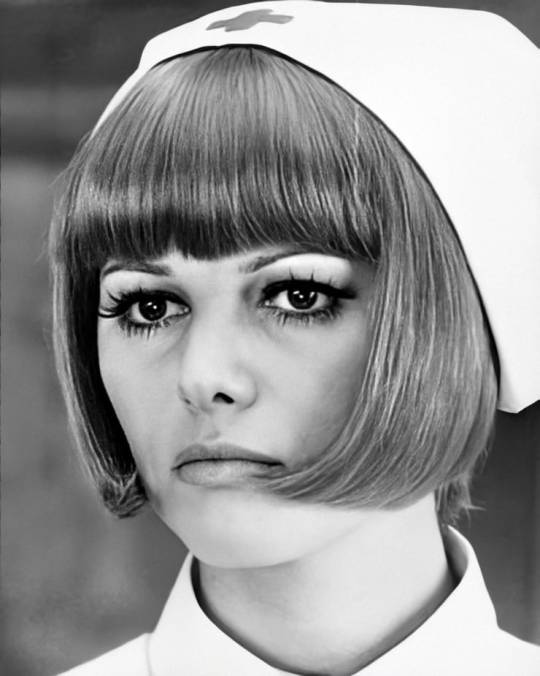
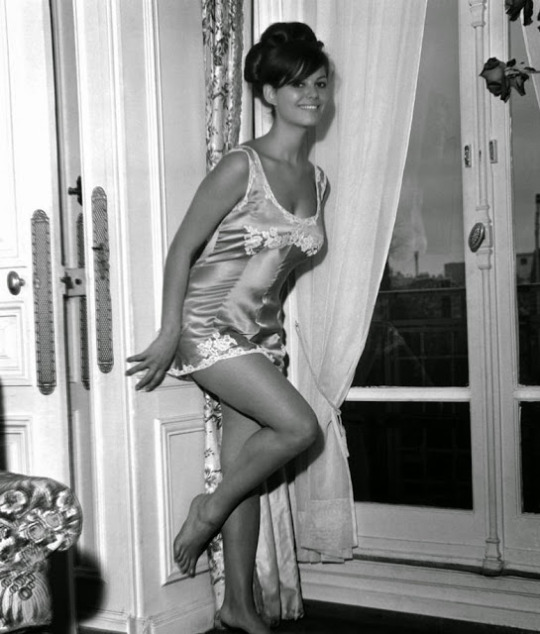


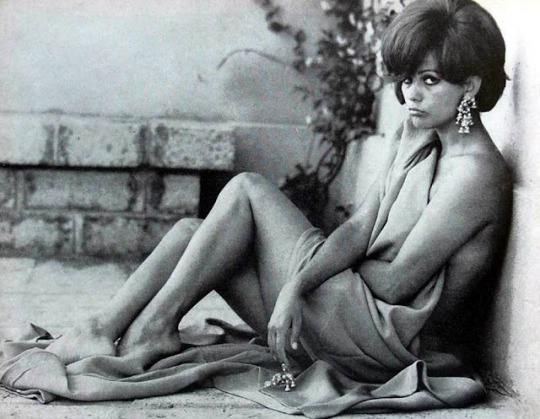
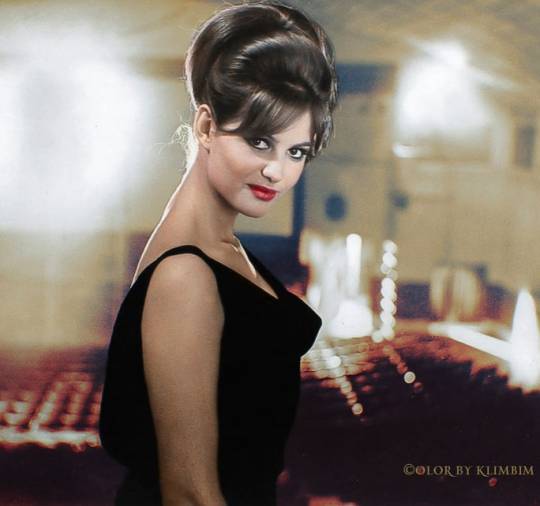
Happy Birthday To Stunning Italian Actress Claudia Cardinale
(Born 15th April 1938)
#claudia cardinale#birthday girl#born 15th april 1938#stunning italian actress#tunisian born#trade marks: natural brunette hair - dark flashing eyes - incredible smile - voluptuous figure - deep seductive voice#best known for her roles in 8 1/2 - the pink panther (both 1963) - the magnificent showman (1964) - once upon a time in the west (1968)#127 acting credits to date#years active 1956-present#european and hollywood films#tv movies & tv series
165 notes
·
View notes
Photo

Happy Birthday Claudia Cardinale, born 15th April 1938
240 notes
·
View notes
Text
Moors Murders - Ian Brady & Myra Hindley
Serial Killer Masterlist
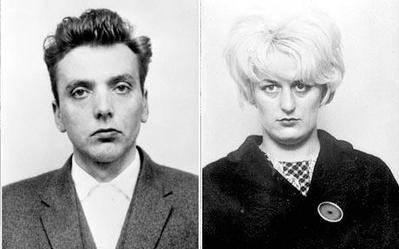
Ian Brady
General Information
Full Name: Ian Duncan Stewart
Born: 2nd of January 1938, Glasgow, Scotland.
Died: 15th of May 2017, Ashworth Hospital.
Cause of Death: Heart failure caused by a severe lung disease.
Faith: N/A
Family
Parents:
Margaret "Peggy" Stewart (Mother)
Father has never been named however Margaret said he was a reporter within Glasgow who passed away 3 months before Brady’s birth.
Siblings:
No biological siblings but had 4 foster siblings.
Partner:
Myra Hindley
Children:
None
Physical Description
Height: 1.83m or 6ft
Weight: 8 stone or 50kg (he was ill at the time of this weight being recorded)
Skin Colour: White
Hair Colour: Brown
Eye Colour: Blue
IQ: N/A
Mental/Physical Illnesses
He suffered from light sensitivity after having measles when he was a toddler. He was diagnosed as either a paranoid schizophrenic or narcissistic personality disorder.
Crimes (Some apply for Hindley as well)
Known Crimes: Murder and Sexual Assault.
Nickname(s): ‘The Moors Murderers’.
Span of Known Murders: 12th of July 1963 - 6th of October 1965.
Known Number of Murder Victims: 5
Possible Number of Murder Victims: 5
Youngest Murder Victim: 10 years old
Oldest Murder Victim: 17 years old
Caught and Arrested: 7th of October 1965.
Trial: 19th of April 1966 - 3rd of May 1966.
Charged with:
Murder
Sentenced to:
2 Sentences of Life Imprisonment
M.O: They would lure their victims - between the ages of 10 and 17 - to their the car with some form of excuse. After forcing the victim into the car Brady would rape them, both would abuse the victim and would finally kill them by strangulation or slashing their throat.
What created the Killer: There is some reports that he tortured animals as a child but he has denied these accusations. He appeared in front of a juvenile court on 2 occasions for breaking into houses.
Quote
“Good laws left to the interpretation of evil men are no longer good.”- Ian Brady.
Myra Hindley
General Information
Full Name: Myra Hindley
Born: 23rd of July 1942, Manchester, England.
Died: 16th of November, 2002.
Cause of Death: Respiratory failure after Bronchial pneumonia.
Faith: Catholic
Family
Parents:
Bob Hindley (Father)
Neillie Hindley (Mother)
Siblings:
Maureen (Sister)
Partner:
Ian Brady
Children:
N/A
Physical Description
Height: 5′5 or 1.65m
Weight: 8 stone then dropped to 7 stone after a hunger strike.
Skin Colour: White
Hair Colour: Brown (Naturally)
Eye Colour: Blue
IQ: N/A
Crimes
Known Crimes: Murder and Sexual Assault.
Span of Known Murders: 12th of July 1963 - 6th of October 1965.
Trial: 27th of April 1966 - 6th of May 1966.
Charged with:
Murder
Sentenced to: .
2 Life Sentences
What created the Killer: Her alcoholic father regularly beat her when she was young and the living conditions of their house was very poor. It only got worse when her younger sister was born.
Quote
"After the first murder, as we were driving home, he told me that if I'd shown any signs of backing out, I would have finished up in the same grave as Pauline." - Myra Hindley.
If you think I have any facts wrong feel free to inform me, this is just information I have gathered from the internet.
#moors murders#moors murderers#ian brady#myra hindley#serial killer#serial killers#killer#killers#murder#murders#murderer#murderers#serial killer summary#true crime#true crimes#solved case#crime#crimes#criminal#criminals#tcc#tcc blog#true crime blog#horror#true horror#true crime community#unsolved case
87 notes
·
View notes
Text

• Hermann Hoth
Hermann Hoth was a German army commander and war criminal during World War II. He fought in the Battle of France and as a panzer commander on the Eastern Front.
Born in Neuruppin, German Empire on April 12th, 1885, Hoth joined the army in 1903 and was awarded both classes of the Iron Cross during World War I. He remained in the Reichswehr (the armed forces of the Weimar Republic) in the interwar period. Following the reorganization of the German military into the Wehrmacht in 1935, he was appointed to command the 18th Infantry Division. Hoth was promoted to Lieutenant-General and given command of the XV Motorised Corps in 1938, leading it in the invasion of Poland the following year. During the invasion of France in May 1940, his panzer corps was on Guderian's right flank during their advance through the Ardennes, and contained the 5th Panzer and 7th Panzer Divisions. Hoth was promoted to Generaloberst in July 1940.
In Operation Barbarossa in 1941, Hoth commanded the 3rd Panzer Group which captured Minsk and Vitebsk as part of Army Group Center's operations. In mid July, the 3rd Panzer Group was subordinated to Army Group North to shore up the flanks and attempted to seize Velikie Luki. Hoth's forces were driven back on July 20th, when Red Army forces broke through the German lines, prompting criticism from Field Marshal von Bock, commander of Army Group Center for unnecessarily striking out too far to the north east. In mid to late August, Hoth's forces faced another setback owing to heavy losses and dispersal of efforts: facing the heavily reinforced Soviet 19th Army, he committed the 7th Panzer Division without infantry support, which resulted in what historians described as "debacle". The division's attack ran into fortified Soviet lines and was repulsed with the loss of 30 tanks. As with all German armies on the Eastern Front, Hoth's Panzer Group implemented the Commissar Order. According to reports from subordinate units, the order was carried out on a widespread basis. In October Hoth was appointed commander of the 17th Army in Ukraine. Hoth was an active supporter of the war of annihilation (Vernichtungskrieg) against the Soviet Union, calling on his men to understand the need for "harsh punishment of Jewry". Under Hoth's command, units of the 17th Army took part in the hunt for and murder of Jews in its territory of control. Following the issuance of the Severity Order by Walter von Reichenau in October 1941; he issued the following directive to troops under his command in November 1941. "Every sign of active or passive resistance or any sort of machinations on the part of Jewish-Bolshevik agitators are to be immediately and pitilessly exterminated".
During the Soviet winter offensives of early 1942, Hoth's 17th Army was driven back in the Second Battle of Kharkov. In June 1942, he took over from General Richard Ruoff as commander of 4th Panzer Army. As part of Operation Blue, the German offensive in southern Russia, the army reached the Don River at Voronezh. Hoth was then ordered to drive to Rostov-on-Don. It then advanced to the north in support of the Sixth Army's attempt to capture Stalingrad. In November 1942, the Soviet Operation Uranus broke through the Axis lines and trapped the Sixth Army in Stalingrad. Hoth's panzer army led the unsuccessful attempt to relieve the Sixth Army (Operation Winter Storm), under the overall command of Field Marshal Erich von Manstein's Army Group Don. By December 25th, the operation had failed.
In February 1943, Hoth's 4th Panzer Army participated in the counteroffensive against the Soviet forces advancing in the Donbass region. The operation was hastily prepared and did not receive a name. Later known as Third Battle of Kharkov, it commenced on February 21st, as the 4th Panzer Army launched a counter-attack. The German forces cut off the Soviet mobile spearheads and continued the drive north, retaking Kharkov on March 15th, and Belgorod on March 18th. Exhaustion of both the Wehrmacht and the Red Army coupled with the loss of mobility due to the onset of the spring rasputitsa resulted in the cessation of operations for both sides by mid-March. The counteroffensive left a salient extending into the German area of control, centered around the city of Kursk, and leading up to Operation Citadel. In July 1943, Hoth commanded the 4th Panzer Army in the Battle of Kursk as part of Army Group South. Operation Citadel called for a double envelopment, directed at Kursk, to surround the Soviet defenders and seal off the salient. The Army Group South committed Hoth's 4th Panzer Army, alongside Army Detachment Kempf. Hoth's divisions, reinforced by the II SS Panzer Corps under Paul Hausser, penetrated several Soviet defensive lines, before being brought to a halt in the Battle of Prokhorovka. In the aftermath of Kursk, the Red Army mounted a series of successful offensives that crossed the Dnieper, retook Kiev and pushed the Germans out of eastern Ukraine. In September 1943, Hoth's army was operationally penetrated by Red Army units and was unable to maintain a continuous front line even in retreat. The army crossed the Dnieper south and north of Kiev with heavy losses. On December 10th, 1943, Hoth was relieved of command, and was not recalled until April 1945.
Following the end of the war, Hoth was tried at the Subsequent Nuremberg Trials, in the High Command Trial. During his testimony he sought to explain his November 1941 order aimed at elimination of the "Bolshevik-Jewish resistance". He claimed that his instructions only meant that his troops should be vigilant and were intended to improve morale: "The German soldier in his good nature ... easily forgot that he was still in enemy territory" and that the "power of Bolshevism had to be broken". He insisted that no physical harm came to civilians as the result of this measure, which his troops executed with "clean hands". Hoth maintained that if any Jews had been killed it was due to their connection to crimes against the German forces. "It was a matter of common knowledge in Russia that it was the Jew in particular who participated in a very large extent in sabotage, espionage, etc.," Hoth claimed. Hoth was found guilty of war crimes and crimes against humanity. On October 27th, 1948 he was sentenced to 15 years in prison. In January 1951, the sentence was reviewed with no changes. Hoth was released on parole in 1954; his sentence was reduced to time served in 1957. Hermann Hoth died on January 25th, 1971 in Goslar, West Germany, he was 85.
#second world war#world war 2#world war ii#wwii#military history#history#german history#biography#operation barbarossa#eastern front#stalingrad#panzer division#long post
58 notes
·
View notes
Text

Happy Birthday Claudia Cardinale, born 15th April 1938
16 notes
·
View notes
Text
Toivo Koljonen


Toivo Harald Koljonen was born on 12th of December 1910 in Lahti, Finland. His family wasn’t wealthy and when his parents divorced, Koljonen had to take care of himself, only being 13 years old. He supported himself by doing various jobs, circling around Southern Finland. During this time he already did some small crimes. In 1930s when Koljonen was around 20 years old he lived in Helsinki for a while and worked as a painter. He was also married for a while and got two children as a result.
In September 1938 Koljonen was sentenced to three years in prison for assaulting a young woman in 1936. He complained to the court of appeals but his sentence stayed the same. He served his sentence in Kakola prison in Turku.
Koljonen took part in the Winter War. During the Interim Peace in September 1940 Koljonen and couple other men stole a lot of fuel to be sold to car owners in Helsinki. During the war times, fuel was rationed strongly. In 1941 Koljonen was sentenced to 4 years and 10 months to penitentiary for multiple thefts and firearm crimes. Koljonen started serving his sentence in Riihimäki prison but he was moved to prison in Huittinen in September 1942. Koljonen was described as a stable prisoner who never really gave reasons for notes. However on 15th of March 1943 Koljonen escaped the prison.
When the prison staff noticed his escape, he already had gained a good head start and managed to lose his chasers. At night approximately 9 pm Koljonen tried to get into a house that was close to the prison, but the elderly woman living there did not let him in. After Koljonen left, the woman immediately went to the prison and informed she had had a visitor knocking on her door. Two guards left with bikes to search Koljonen. On the next day the woman noticed her axe was missing from the shed. People weren’t very worried about Koljonen being on the run since during the war times there were also deserters and parachute spies (Finnish: desantti, Russian: desantnik, from French: descendre ‘get down’), who were missing. They were considered a lot more dangerous than Koljonen could be.
On 17th of March after couple of days hiking around forests Koljonen broke into a house. He was starving, tired and cold. The householder Kalle Hakanen had heard through a radio that there was an escaped prisoner and during the last night Hakanen had driven Koljonen away when he had been asking for a shelter. Hakanen had recognized Koljonen being the escaped prisoner. Now Koljonen went to the kitchen and took some bread to eat when Hakanen came in and surprised him. Koljonen killed Hakanen with the ax he had stolen from the elderly woman’s house and after a short fight he also killed Hakanen’s wife Anna Hakanen. Next Koljonen attacked their daughter working in the cowshed - who also was named Anna Hakanen - and killed her. After that Koljonen went back to the house and killed the two youngest children, aged 6 and 11 who were crying in their beds. When Koljonen was leaving the house, he bumped into a neighbour, Anna Mäkinen, who he also killed. The only survivor from the Hakanen family was their 18 year old son who was at the time of the murders fighting in the war. He was released from his service when the news about the murders came to light. The next day the murder was front page news and Aamulehti immediately announced that Koljonen was a suspect.

The murders touched so many people and in total 4 000 people attended the family’s funeral, which was held on 4th of April 1943. Most of the attendee’s were unfamiliar to the family.

After the murder Koljonen fled the scene with a bike he stole. He went to Tampere and continued from there to Valkeakoski accompanied by a man he met in Tampere. He sold the bike in Tyrvää. Koljonen was running away for two weeks and during that time he started to strongly regret murdering the family. The police were looking for a deserter at the end of March when they visited a cabin in Viranmaa. There they found Koljonen and quickly arrested him. Koljonen was taken to Huittinen. The murder weapon was found from the crime scene from a dunghill where Koljonen had hid it. When the police were interrogating Koljonen, he wasn’t able to tell any motive for the murders. He was sent to Kakola prison in Turku to wait the trial.
The trial was in Huittinen on 19th of April 1943 and it lasted for 12 hours. There were 31 witnesses. The only surviving member of the Hakenen family and the brother of Anna Mäkinen demanded compensation. Koljonen was sentenced to one year in prison for fleeing, one year in penetentiary for grand theft and to death for the six murders (the state of war made it possible to sentence him to death). Koljonen was also charged to pay 22 000 Finnish marks for different compensations. There had been rumors going around that Koljonen was mentally unstable, but the head warden in Huittinen prison and one doctor in Huittinen strongly denied this. The court saw that the murders were exceptionally cruel and brutal because of the way they were committed, how many victims there were, and because two of the victims were children. The prosecutor demanded the court to deny Koljonen’s appeal to be mentally evaluated. The court of appeals and the supreme court did not change his sentence and the current president of Finland during that time, Risto Ryti (who happened to be from Huittinen) turned down Koljonen’s plea for pardon. Koljonen was shot in October 1943 in a shooting range located in Turku. At the same time was also shot two spies of the Red Army. Koljonen was the last Finn executed for a civilian crime.
According to a doctor of Jurisprudence Jukka Lindstedt, between the years 1939 to 1946 in Finland 42 sentences for murder were death sentences. However only 13 were executed, which was a small number considering how many people were sentenced to death for other crimes: spies, saboteurs and underground communists (about 30 were death sentences), deserters ( about a 100), parachute spies (over 400). Eight of the 13 people executed were Finnish and five were Soviets. One of the Finns was soldier Eetu Peltonen, who had shot shopkeeper Väinö Närvänen, his wife and mother with a machine gun in 13th of February 1944, and burned their estate after the murders.
After
The war made it possible for people to quickly forget about the murders and Koljonen himself. No one didn’t really note the execution of Koljonen, and even in Huittinen it wasn’t front page news. The murders and Koljonen as a person however stuck in the minds of people living in Huittinen for a long time, and even after decades it was hard for them to deal smoothly with people who had the same last name as the murderer, even though it is pretty common last name.
21 notes
·
View notes
Text
From website: Pittsburgh Music History.
Pittsburgh Dance Instructor becomes Oscar wining star of
"An American in Paris"
and "Singin' In the Rain"
Gene Kelly was the leading star in the classic Hollywood movie musicals from the mid 1940s through the late 1950s. Multi-talented he was a singer, dancer, choreographer actor, film director and producer. Audiences love his delightful singing, his athletic dancing, his charming good looks, and his likeable characters. He is credited for reviving movie musicals and redefining dance in films. Kelly was honored with lifetime achievement awards from the Academy Awards, the Kennedy Center Honors, the Screen Actions Guild, and the American Film Institute. The American Film institute ranks him 15th on their list of “Greatest Male Stars of All Time”. His most memorable performances include starring roles in Singin’ in the Rain, An American in Paris, On the Town, and Anchors Aweigh. Gene was the star and choreographer of the film ‘An American in Paris” which won 8 Oscar awards including best picture and a special Oscar for Gene recognizing his contributions to screen choreography. Singin’ in the Rain, called "a movie masterpiece" by Vincent Canby of the New York Times, has been voted the most popular movie musical of all time.
Growing Up in Highland Park
Born Eugene Curran Kelly in Pittsburgh on August 23, 1912, Gene Kelly grew up in on Mellon Street in Highland Park. He attended St. Raphael’s elementary school and was an altar boy at the church. His Canadian born father James Patrick Joseph Kelly was as sports lover and a sales executive for the Thomas Edison's Columbia Phonograph Company. Every winter James, who loved hockey, flooded the backyard to make an ice hockey rink for the family. Gene learned to skate at age 5.
Gene's mother Harriet, who as a hobby performed in local stock productions, made all five of her children take music and dance lessons. She enrolled the eight year old Gene in dance classes at Blinsky’s School of the Dance on 6th and Penn in downtown Pittsburgh. The Kelly kids Jay, Jim, Gene, Louise, and Fred began performing dance routines around 1921 as "The Five Kellys" at amateur vaudeville nights and charity events.
After getting in fist fights with neighborhood kids who called him a sissy, Gene quit dancing. He preferred sports. He played on a men's amateur hockey team age at 14 and dreamed of playing for the Pittsburgh Pirates.
The Kelly's moved from Highland Park to 7514 Kensington Street in the Point Breeze neighborhood near Frick Park in 1924. Gene attended his first year of high school at the Sacred Heart School.
At age 15 Gene thought dancing would be a good way to meet girls, so he began dancing again. He took dance lessons while also playing on his high school football, baseball and hockey teams. He also participated in gymnastics.
Graduating from Peabody High School in 1929 he enrolled at Penn State to study journalism. With the 1930 stock market crash hurting the Kelly family’s finances, Gene left Penn State planning to cut costs by living at home while studying at the University of Pittsburgh. He dug ditches, pumped gas, worked as a soda fountain jerk and carpenter's helper, and danced to earn tuition money. Gene and his younger brother Fred devised dance routines and found work dancing in local nightclubs as the “Kelly Brothers”.
Gene Kelly Studio of Dance
Gene’s mother took a job as a receptionist at Boulton's dance school in Pittsburgh’s Squirrel Hill neighborhood. When the owner Lou Boulton skipped town leaving behind a pile of unpaid bills, Harriet took over the dance school. She paid the bills and renamed it the "Kelly School of Dance". Gene at age 19 and his brother Fred became dance instructors. Gene worked as a dance instructor while he attended studies at Pitt. He taught tap, toe and ballet. To learn routines Gene went to night clubs, movie musicals and vaudeville shows. He'd teach them the next day in his classes. With Gene’s growing reputation as a teacher the studio was renamed The "Gene Kelly Studio" of the Dance in 1932. The Kelly’s opened a second dance school on the main street of Johnstown, Pennsylvania in 1933. Gene taught at the Johnstown school on weekends. He continued to teach dance for six years.
The dance school was a great success, but Gene was not content being a teacher. He want to be a choreography and director. Gene wanted to combine the styles of ballet and tap-dance into a new American dance for. To learn ballet he took classes from ballet masters in Chicago and New York during the summers. Gene attened classes at Chicago Association of Dancing Masters. Seeing his talent the school asked him to a few classes. Gene also read every book that he could find on ballet in English and French. He practiced constantly. Putting his skills into practice Gene danced in an choreographed musicals while attending at the University of Pittsburgh.
Pitt's Cap and Gown Musical Reviews
Gene enrolled at the University of Pittsburgh in 1931 studying economics. At Pitt he joined the Cap and Gown Club, which staged four times a year at the Stephen Foster Memorial Theater along with an an annual event at the Nixon Theater. Gene performed in the original musical comedy productions written by members of the Cap and Gown Club. Completing a Bachelor of Arts in Economics in 1933, Gene then enrolled in the University of Pittsburgh’s Law School. After two months of study groups and torts Gene decided that he wanted to be an entertainer and dance teacher. He dropped out of school to pursue his entertainment career full-time teaching at the dance studio and doing performances. Gene remained a member of Pitt’s Cap and Gown Club serving as its serving as its dance director from 1934 to 1938. He was the assistant director of their 1936 Nixon Theater show "Out for the Count". Gene first created his rolling skating dance routine in the Cap and Gown's production of "Tt's Always Fair Weather". Gene directed the club's 1937 production of "Trailer Ho" at the Nixon and then took the show on the road for performances in Johnstown, Bradford and Erie. In 1938 Gene Kelly choreographed and directed the Cap and Gown show "Pickets Please" at the Nixon.
In addition to his work with the Cap and Gown Club did choreography for vaudeville and other organizations. Vaudeville acts that passed through Pittsburgh during the 1930’s hired Gene to create dance routines. In 1931 the Rodef Shalom Synagogue hired Kelly to teach dance and stage the annual Kermess show. He kept that position for seven years. Gene continued to perform with his brother. The Kelly Brothers performed in a theater for children at the Chicago World's Fair in 1934.
Broadway Stardom
In 1937 at the age of 27 Gene moved to New York City to become a choreographer. Unable to find work on Broadway, he returned to Pittsburgh to be the choreographer of the musical revue “Hold Your Hats” at the Pittsburgh Playhouse in the spring 1938. He also danced in the production. At the Playhouse, Gene was seen by Broadway choreographed Robert Alton. Alton brought Gene to Broadway making him a star.
On August 5, 1938 just before his 26th birthday, Gene packed one small suitcase and returned to New York for his first role. Alton hired Gene for a Cole Porter musical giving him his first dancing role on Broadway in November of 1938 as a chorus boy in "Leave It to Me". Alton gave Gene a feature singing and dancing role in his next production “One for the Money”. In 1939 Gene choreographed and danced in in the Pulitzer Prize-winning "The Time of Your Life". Also in 1939 he choreographed Billy Rose's Diamond Horseshoe. He danced his way into the heart of cast member Betsy Blair, whom he married in 1941. Gene became a major star in 1940 with his leading role in Rodgers and Hart's Pal Joey choreographed by Robert Alton.
Movie Musical Superstar
With his rise to stardom, Hollywood called. His role in Pal Joey captured the interest of Louis B. Mayer and Judy Garland. Gene signed with MGM's David O’Selznick in 1941. He was cast as Garland's romantic lead in his first movie For Me and My Gal (1942), His breakout move role was in Anchors Aweigh in 1945.
After a long career as one of the world’s most beloved musical performers Gene Kelly died in 1996.
Singin' In The Rain
The Five Kelly's
The Kelly Brothers
Cap and Gown Club Production 1938
Pal Joey
All Music Guide
Gene Kelly Internet Movie Database
References
Pitt Cap and Gown Club In Annual Show at Nixon by Harold W. Cohen Pittsburgh Post Gazette April 23, 1936
Pitt Club Plans Show -The Pittsburgh Press April 7, 1936
Annual Pitt Show Satire on Dictators Pittsburgh Post Gazette April 2, 1938
The Kelly Kids -Harold W. Cohen Pittsburgh Post Gazette September 4, 1940
MR. KELLY, OR PAL JOEY; Portrait of a Dancer, From Pennsylvania To the Barrymore Theatre - Robert Van Gelder New York Times March 02, 1940
Gene Kelly Got to the Top Via a "Different" Route -Pittsburgh Post Gazette Dec 3, 1942
Gene Kelly Said He Never Wanted to be a Movie Star -Tom Shales Pitsburgh Press June 29. 1974
How Did Gene Start Dancing -Debra Gene GeneKellyFans.com Jul 20, 2011
3 notes
·
View notes
Text
Armenian Women in Visual Arts

I took a class on Armenian culture and history in university that exposed me to this beautiful country and people and opened my eyes to the undeniable tragedy of the Armenian Genocide of 1915.
I’m not Armenian, but I’m Greek on my dad’s side which I found out is very similar. We both love our dolma’s and hate the Turks. But in all seriousness, we share a lot of similarities with Armenian culture, including its political history, which has helped me to further empathize with the current struggles they are facing as a country. It's heartbreaking to see that, just five years after the 100 year anniversary of the Armenian Genocide, Armenians appear to be facing a second genocide. Armenia’s neighboring country Azerbaijan has been ensuing deadly attacks against them for some time now with the aid of Turkey and the issue continues to be mostly ignored by the international community. Protests have been raging on both in the nation and diaspora. In no way do I consider myself to be an expert on this subject, but I feel responsible at least to educate myself and do my part as a citizen of the world.

There is no civilization in the world that, given it possess the resources and will, doesn’t have artists, doctors, lawyers, chefs, musicians, poets, farmers, accountants, etc... The meaning of this to me is that it is proof we are all valuable people, no matter where we come from or what we look like. Just think about how sand is made from millions of tiny parts but looks like one uniform blanket on the beach. If you were to put a handful of sand into a jar, and another handful into another jar, you’d find that each jar is made up of entirely different rocks. But somehow, both have all the elements needed to still look like a handful of sand. That’s how I view culture. Every culture is a handful of sand; they all have necessarily found their own way to explain the universe (religion), their own way to communicate (language), their own way to nourish themselves (diet), and so on... and each way is original and different. But somehow, all of the elements add up to create a civilization, a culture, and a people with a shared identity. The only thing that makes us different is that we’re arbitrarily placed into one jar and not another, but when you look at the big picture, we’re all the same.

As embarrassing as it is to admit, I think by human nature it’s much easier to care about someone else’s journey in life when they have something in common with you. What I love about art is that when you meet another artist, no matter who, you feel a sort of magical connection to that person and are bonded over your mutual appreciation of it. I am a woman and I am an artist, and because of that, I feel lucky and unworthy in saying I have something in common with these incredibly talented Armenian women that I’m about to share with you.
I. Zabelle Boyajian (1872-1957)
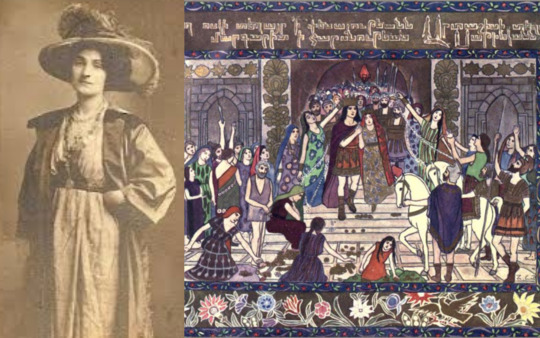
Zabelle C. Boyajian was a poet, painter and playwright of the Ottoman Empire, born in 1872 in Diyarbakir, one of the ancient Armenian capitals, ‘Tigranakert’. After the murder of her father during the Hamidian Massacres of 1895, she, her mother and her brother immigrated to London. She travelled extensively throughout her lifetime and learned to speak eight languages fluently, including Armenian, English, German, Italian, Greek, Turkish and Russian. Being skilled in so many languages, apart from the arts, she was a great contributor to the translation of many great Armenian works. For example, in 1948, she translated Avetik Isahakian’s epic poem “Abu Lala Mahari” and published it for the world to read. In 1938, thanks to her wide travels, she published several illustrations from her visit to Greece, entitled “In Greece with Pen and Palette”. Exhibitions of her art were held in London, Egypt, France, Italy, Belgium and Germany. She was close friends with Anna Raffi, the wife of the well-known Armenian novelist, Raffi. One of the leading female trailblazers of art, literature and translation, she published her first novel in 1901, entitled “Esther”. She is well known today for her gorgeous storybook illustrations.
II. Miriam Aslamazian (1907-2006)

Miriam Aslamazian, sometimes called the Armenian Frida Kahlo, was born on October 20th, 1907 in Alexandropol in the village of Bash-shirak. She was was a Soviet painter of Armenian descent recognized for her exquisite ceramic plates. In 1929, she graduated from the Yerevan Art-Industrial Technicum and later in 1933, from the Leningrad Academy of Art. In 1946, she became a member of the CPSU (the Communist Party of the Soviet Union). Her work is often described as decorative, flat still-life pieces as well as possessing dramatic, colorful themes. Many pieces of her artwork can be found today in the Aslamazian Sisters’ Museum in Gyumri. She was honored as People’s Artist of the Armenian SSR 1965 and People’s Artist of the Soviet Union in 1990.
III. Gayane Khachaturian (1942-2009)

Gayane Khachaturian, born May 9th, 1942 in Tbilisi, Georgia, was a Georgian-Armenian graphic artist and painter. She studied at the Nikoladze Art School and the Secondary School of Working Youth, where she graduated in 1960. Sergei Parajanov, who she was close friends with, was a major inspiration for her. Some of her works are permanently displayed and can be seen at the National Gallery of Armenia, the Yerevan Museum of Modern Art as well as the Sergei Parajanov Museum in Yerevan. Her works have also been purchased and are included in several private art collections. Her first informal solo exhibition was at Skvoznyachok Café in Yerevan in 1967.
IV. Sonia Balassanian

Sonia Balassanian is a mixed media artist, art curator, founder and Artistic Director of the Armenian Center for Contemporary Experimental Art in Yerevan, Armenia. Born in Iran of Armenian descent on April 8th of 1942, Balassanian uses her artwork to advocate for human rights and women's emancipation issues. In 1970, she obtained a BFA from the Pennsylvania Academy of Fine Arts and the following year worked on an independent study program at the Whitney Museum of American Art. In 1978, she completed her MFA from Pratt Institute in Brooklyn, New York. The following year, however, the 1979 events in Iran caused her to turn to “political art” as self expression. She is also a skilled writer, publishing several works, including, “There Might Have Been An Insane Heart” (1982), composed of selected poems written in the Armenian language, “Portraits” published in New York in 1983 and “Two Books” (2006), a publication of two books of poems in one combined.
V. Nora Chavashian

Nora Chavashian is an award-winning production designer, art director and set decorator, recognized for her sculptural stage sets, born in Philadelphia, PA on October 25th, 1953. OMG we have the same birthday, no wonder I like her! There, she studied sculpture at the Pennsylvania Academy of Fine Arts. In 1974, Chayashian graduated from the San Francisco Art Institute (SFAI). In 1984, she married Joe Morton, an American actor, director, writer, singer and songwriter, with whom she has three children, Hopi, Seta and Ara, and one grandson, Moses. In 1988, she and her family relocated to the East Coast. Her sculptures often have organic shapes and are reminiscent of nature.
VI. Anush Yeghiazaryan

Anush Yeghiazaryan is a painter, weaver and professor born on June 15th, 1965 in Yerevan, Armenia, known for her stunning tapestry creations. Hailing from the family of Karapet Yeghizaryan, patriarch of the Armenian school of art weaving, she has held up the traditional weaving techniques of her ancestors. From 1984 to 1990, she studied graphic design at the Yerevan State Fine Arts Academy. From 1991 to 1994, she worked on obtaining her PhD from the State Armenian Pedagogical University. In 1996, she became a member of the Armenian Union of Artists. In 2010, Yeghiazaryan joined the Pan-Armenian Painting Association. She has had her work presented in exhibitions around the world, from Yerevan to Paris, Moscow, Sankt Petersburg, Bouve, Plovdil, Tehran, Italy and Praha. Quoted for saying, “I have not chosen art, it’s in my blood. It’s my lifestyle and I love it up to sublimation degree”. Some of her pieces displaying masterful weaving techniques include,“If you live, create” (1998), “Once Upon a Time in Paris” (2003), and “Urbanization” (2006).
VII. Taleen Berberian

Taleen Berberian is a modern Armenian visual artist, specializing in mixed mediums, crafted fabric, clay sculptures, drawing and the use of the traditional Armenian sewing, embroidery and crochet techniques in unconventional ways. She is especially recognized for her famous sculptures of shoes. Berberian has been on the forefront of women’s issues, a theme that can be seen through her artwork. She is an active participant in both Los Angeles and New York’s art communities. In 1995, she obtained a BFA in Sculpture from the California College of the Arts in Oakland, California and in 1998 she continued on to achieve a MFA in Studio Art and Art Education from Pratt Institute in Brooklyn, New York. In 2009, she received her Initial Teachers’ Certification in Visual Art for grades K-12 and currently serves as a quilting and ceramics instructor.
VIII. Joanne Julian

Found out artist Joanne Julian and I are both CSUN alum and native Angelenos! Julian, who is of Armenian ancestry, says she has been highly influenced by her travels to Asia and thus became skilled in certain Asian techniques, such as mono printing and the “flung ink” or “Haboku” style. Her pieces possess a “Zen quality” to them, as portrayed in her “Zen Circle” series, illuminating the Yin and Yang of Taoist painting. She received her Bachelor’s of Arts and her Masters in sculpture and printmaking from California State University, Northridge. She later received her MFA from the Otis Art Institute of Parsons School of Design. She has participated in over sixty group exhibitions and twenty solo exhibitions nation-wide. Since 1973, Julian has served as the Chair of the Fine Arts Department and Gallery Director at the College of Canyons in Valencia, California. In 2008, from January 25th to February 23rd, she held an exhibition at CSUN’s Art Gallery entitled, “Counterpoints”.

All of the female artists I mentioned have given people a better look into what it means to be Armenian and how the community and its diaspora are trying to solidify the Armenian identity to enable its rich heritage and traditions to live on. And they are just a few of the proud Armenians who have helped raise awareness of the issues Armenians face, as well as give Armenians their due respect in the realm of International Art. And to go one step further, my deepest hope is that one day, art will overcome the war.
#armenian#armeniangenocide#genocide#journalism#armenianprotests#azerbaijan#femaleartists#artists#art#artist#femaleartist#armenianart#armenianartist#armenianartists#armenia#culture#zabelleboyajian#joannejulian#taleenberberian#anushy#Miriamaslamazian#Sonia Balassanian#soniabalassanian#female artists#armenian genocide#armenian artists#armenian art#armenianwomen#armenian women#peaceforarmenians
14 notes
·
View notes
Text

— 𝐓𝐈𝐌𝐄𝐋𝐈𝐍𝐄 𝐎𝐅 𝐒𝐓𝐄𝐕𝐄 𝐑𝐎𝐆𝐄𝐑𝐒 / 𝐂𝐀𝐏𝐓𝐀𝐈𝐍 𝐀𝐌𝐄𝐑𝐈𝐂𝐀 ,
* this is subject to change as i think of more to add, but this is the basis and the timeline that i will be following throughout my default verse. only really taking inspiration from the first captain america movie, the rest is all headcanon based.

FEBRUARY 4TH, 1893: joseph ‘ joe ’ steven rogers is born in dublin, ireland to steven william john rogers and mary-ann helen rogers.
AUGUST 15TH, 1895: sarah colleen collins is born in dublin, ireland to ian grant collins and elizabeth jean collins.
APRIL 9TH, 1913: joe and sarah get married in dublin, ireland.
UNKNOWN DATE, 1913: joe and sarah immigrate to brooklyn, new york city to live the american dream.
JULY 28TH, 1914: the great war (world war one) begins.
UNKNOWN DATE, 1914: joe is enlisted into the war, serving in the 107th infantry. sarah serves as a nurse back in new york.
UNKNOWN DATE, 1918: joe is shot overseas and is honourably discharged.
JULY 4TH, 1918: steven grant rogers is born in new york city, usa to joseph steve rogers and sarah colleen rogers.
NOVEMBER 11TH, 1918: the great war ends.

UNKNOWN DATE, 1920: joe is employed at the docks, sarah continues to work at the hospital as a nurse.
UNKNOWN DATE, 1923: joe loses his job at the docks, he struggles to pick up another and turns to alcohol and gets heavily involved with loan sharks and taking out loans. the rogers’ family is in debt.
UNKNOWN DATE, 1924: steve starts attending the florence nightingale school.
SEPTEMBER 23RD, 1926: joe rogers dies of influenza. steve is eight years old.
UNKNOWN DATE, 1926: steve rogers meets james buchanan ‘ bucky ’ barnes.
UNKNOWN DATE, 1927: sarah begins taking on additional jobs, atop her shift as a nurse to keep a roof over her and steve’s head, but hopefully begin to pay off the debt left to the loan sharks after joe’s death.
UNKNOWN DATE, 1930: steve picks up a paper round, to help his mother with paying off his father’s debts.
UNKNOWN DATE, 1931: steve finishes his education at the florence nightingale school and begins attending george washington high school.
UNKNOWN DATE, 1935: steve finishes his education at the george washington high school.
NOVEMBER 1ST, 1936: sarah rogers dies of tuberculous, steve is eighteen years old. he is now the sole survivor of the rogers’ family.
UNKNOWN DATE, 1937: steve begins attending the auburndale art school with bucky.
UNKNOWN DATE, 1938: steve stops attending the auburndale art school.
UNKNOWN DATE, 1938: down at coney island, steve draws and sells his artwork along the boardwalk for ten cent a piece.
SEPTEMBER 1ST, 1939: world war two begins.

DECEMBER 7TH, 1941: the united states enters the second world war.
UNKNOWN DATE, 1941: bucky trains steve at goldie’s boxing gym before they go enlist together. bucky is accepted, steve is not.
JUNE 14TH, 1943: steve and bucky attend the world exposition of tomorrow before bucky is shipped out. steve is approached by doctor abraham erskine and is recruited into the united states army through project rebirth.
JUNE 15TH, 1943: steve begins his training at camp lehigh, under the supervision of colonel chester phillips.
JUNE 22ND, 1943: project rebirth is put into motion. steve rogers is injected with the super soldier serum and is transform into the world’s first super soldier. abraham erskine is assassinated by an operative of hydra. after erskine’s death, steve is unwilling to be kept around for research and is given an ultimatum.
JUNE 23RD, 1943: steve rogers begins his uso tour as american propaganda. given the name captain america, he becomes a national celebrity, appearing in films, comic books and card collections.
UNKNOWN DATE, 1943: using the money from his uso tour, steve is able to pay off his father’s debt.
NOVEMBER 3RD, 1943: steve’s tour takes him to italy, where he performs for the soldiers fighting overseas. he learns of the 107th capture, which includes the capture of bucky barnes. steve goes behind colonel phillips back and performs a rescue mission behind enemy lines. captain america saved the lives of four hundred men.
NOVEMBER 4TH, 1943: the howling commandos are formed, consisting of steve rogers, bucky barnes, dum dum dugan, gabe jones, jim morita, james montgomery falsworth and jacques dernier.
MAY 6TH, 1944: captain america is present at operation overload (the battle of normandy).
UNKNOWN DATE, 1944: captain america punches h*tler.
UNKNOWN DATE, 1945: outside stalingrad, captain america and the howling commandos rescue over one thousand men.
FEBRUARY 1ST, 1945: the howling commandos board a train and capture armin zola, in the ensuing battle against hydra agents, james buchanan ‘ bucky ’ barnes falls from the train and is presumed dead.
FEBRUARY 4TH, 1945: steve, whilst mourning the death of his best friend vows to defeat hydra and the red skull.
FEBRUARY 5TH, 1945: captain america attacks the hydra headquarters! the red skull escapes in the valkyrie, but captain america boards before take off. an ensuing battle occurs on the ship, until captain america defeats the red skull. the valkyrie was set on auto pilot to fly over major cities across the states and drop bombs, but steve crashes the valkyrie before this can happen, off the coast of greenland. captain america is presumed dead.
MARCH 4TH, 1945: the disappearance of captain america is publicly revealed.
MARCH 5TH, 1945: newspapers and radios begin to report on captain america’s disappearance and presumed death.
MAY 8TH, 1945: the allies accepted germany’s surrender, the war ends in the united kingdom.
SEPTEMBER 2ND, 1945: world war two ends.

OCTOBER 5TH, 2011: a russian oil team discovers the crashed valkyrie. s.h.i.e.l.d. agents are dispatched and whilst exploring the wreck, they found the body of steve rogers, who is still alive and cryogenically preserved in ice.
OCTOBER 7TH, 2011: steve’s body is thawed out of the ice and is moved to new york city.
OCTOBER 8TH, 2011: steve wakes up at a s.h.i.e.l.d base and escapes, only to run out the building into a world he did not recognise.
OCTOBER 9TH, 2011: steve is sent to another s.h.i.e.l.d. base, where he would stay until he was caught up to speed with everything that has happened in the past sixty-six years.
JANUARY 25TH, 2012: steve is released from the s.h.i.e.l.d base and reenters the world.
UNKNOWN DATE, 2012: captain america joins the avengers.
JUNE 4TH, 2012: captain america becomes the face of multiple campaign videos used at schools across the country.
UNKNOWN DATE, 2012: steve rogers meets sharon carter.
OCTOBER 5TH, 2012: on the one year anniversary of captain america being discovered, the smithsonian institution unveils it’s captain america exhibit.
JANUARY 11TH, 2014: captain america fights against the winter soldier, whom he recognises as his presumed death best friend, bucky barnes.
JANUARY 12TH, 2014: captain america fights the winter soldier for the second time. the fight is brutal and steve almost drowns in the potomac river, until he is rescued by bucky and pulled onto the surface.
UNKNOWN DATE, 2015: during an avengers mission, steve rescues a dog and brings him to a local animal shelter. eventually, steve returns to adopt the same dog, naming him cadet.
UNKNOWN DATE, 2016: steve reaches out and begins to rebuild his friendship with bucky barnes, who has now broken free from hydra.
UNKNOWN DATE, 2017: steve starts to hold sessions at the local community center for war veterans, both past and present.
UNKNOWN DATE, 2018: steve begins to volunteer at the f.e.a.s.t centre.
PRESENT DAY: steve rogers is the leader of the avengers, an avid volunteer and a living legend. more to be added.
#⍟・゚: › 𝐡𝐞𝐚𝐝𝐜𝐚𝐧𝐨𝐧 –– remember why you started. don’t give up ‚ find a way.#idk what to tag this as ......#but this is it#this is the timeline i just spent the#last three or so hours working on and i'm tired.#i'm sure i've missed out loads#but i'll fill in the gaps when i need too.#and i kinda gave up with the banners#at the end so take this half ass attempt at them asfjsaklfa#apologises for my#1940's bit just beign hectic i had fun writing that safksalfa#and then my brain#began to melt when i reached the modern day#but uwu here we go.
7 notes
·
View notes
Text
TRYING TO CASH THE PRIZE CHECK
December 9, 1950

“Trying To Cash The Prize Check” (aka “The ‘Everybody Wins’ Prize Check”) is episode #109 of the radio series MY FAVORITE HUSBAND broadcast on December 9, 1950.
Synopsis ~ Liz goes on the radio quiz show and wins a check for $500, but she only gets to keep it if she can cash it within 25 minutes, and the banks are all closed!
This was the 15th episode of the third season of MY FAVORITE HUSBAND. There were 43 new episodes, with the season ending on June 25, 1950.

“My Favorite Husband” was based on the novels Mr. and Mrs. Cugat, the Record of a Happy Marriage (1940) and Outside Eden (1945) by Isabel Scott Rorick, which had previously been adapted into the film Are Husbands Necessary? (1942). “My Favorite Husband” was first broadcast as a one-time special on July 5, 1948. Lucille Ball and Lee Bowman played the characters of Liz and George Cugat, and a positive response to this broadcast convinced CBS to launch “My Favorite Husband” as a series. Bowman was not available Richard Denning was cast as George. On January 7, 1949, confusion with bandleader Xavier Cugat prompted a name change to Cooper. On this same episode Jell-O became its sponsor. A total of 124 episodes of the program aired from July 23, 1948 through March 31, 1951. After about ten episodes had been written, writers Fox and Davenport departed and three new writers took over – Bob Carroll, Jr., Madelyn Pugh, and head writer/producer Jess Oppenheimer. In March 1949 Gale Gordon took over the existing role of George’s boss, Rudolph Atterbury, and Bea Benaderet was added as his wife, Iris. CBS brought “My Favorite Husband” to television in 1953, starring Joan Caulfield and Barry Nelson as Liz and George Cooper. The television version ran two-and-a-half seasons, from September 1953 through December 1955, running concurrently with “I Love Lucy.” It was produced live at CBS Television City for most of its run, until switching to film for a truncated third season filmed (ironically) at Desilu and recasting Liz Cooper with Vanessa Brown.
MAIN CAST

Lucille Ball (Liz Cooper) was born on August 6, 1911 in Jamestown, New York. She began her screen career in 1933 and was known in Hollywood as ‘Queen of the B’s’ due to her many appearances in ‘B’ movies. With Richard Denning, she starred in a radio program titled “My Favorite Husband” which eventually led to the creation of “I Love Lucy,” a television situation comedy in which she co-starred with her real-life husband, Latin bandleader Desi Arnaz. The program was phenomenally successful, allowing the couple to purchase what was once RKO Studios, re-naming it Desilu. When the show ended in 1960 (in an hour-long format known as “The Lucy-Desi Comedy Hour”) so did Lucy and Desi’s marriage. In 1962, hoping to keep Desilu financially solvent, Lucy returned to the sitcom format with “The Lucy Show,” which lasted six seasons. She followed that with a similar sitcom “Here’s Lucy” co-starring with her real-life children, Lucie and Desi Jr., as well as Gale Gordon, who had joined the cast of “The Lucy Show” during season two. Before her death in 1989, Lucy made one more attempt at a sitcom with “Life With Lucy,” also with Gordon.
Richard Denning (George Cooper) was born Louis Albert Heindrich Denninger Jr., in Poughkeepsie, New York. When he was 18 months old, his family moved to Los Angeles. Plans called for him to take over his father’s garment manufacturing business, but he developed an interest in acting. Denning enlisted in the US Navy during World War II. He is best known for his roles in various science fiction and horror films of the 1950s. Although he teamed with Lucille Ball on radio in “My Favorite Husband,” the two never acted together on screen. While “I Love Lucy” was on the air, he was seen on another CBS TV series, “Mr. & Mrs. North.” From 1968 to 1980 he played the Governor on “Hawaii 5-0″, his final role. He died in 1998 at age 84.
Gale Gordon (Rudolph Atterbury) had worked with Lucille Ball on “The Wonder Show” on radio in 1938. One of the front-runners to play Fred Mertz on “I Love Lucy,” he eventually played Alvin Littlefield, owner of the Tropicana, during two episodes in 1952. After playing a Judge in an episode of “The Lucy-Desi Comedy Hour” in 1958, he would re-team with Lucy for all of her subsequent series’: as Theodore J. Mooney in ”The Lucy Show”; as Harrison Otis Carter in “Here’s Lucy”; and as Curtis McGibbon on “Life with Lucy.” Gordon died in 1995 at the age of 89.
Bea Benadaret (Iris Atterbury) was considered the front-runner to be cast as Ethel Mertz but when “I Love Lucy” was ready to start production she was already playing a similar role on TV’s “The George Burns and Gracie Allen Show” so Vivian Vance was cast instead. On “I Love Lucy” she was cast as Lucy Ricardo’s spinster neighbor, Miss Lewis, in “Lucy Plays Cupid” (ILL S1;E15) in early 1952. Later, she was a success in her own show, “Petticoat Junction” as Shady Rest Hotel proprietress Kate Bradley. She starred in the series until her death in 1968.
Bob LeMond (Announcer) also served as the announcer for the pilot episode of “I Love Lucy”. When the long-lost pilot was finally discovered in 1990, a few moments of the opening narration were damaged and lost, so LeMond – fifty years later – recreated the narration for the CBS special and subsequent DVD release.
Ruth Perrott (Katie, the Maid) does not appear in this episode.
GUEST CAST

Frank Nelson (’Happy’ Hal Brubaker) was born on May 6, 1911 (three months before Lucille Ball) in Colorado Springs, Colorado. He started working as a radio announcer at the age of 15. He later appeared on such popular radio shows as “The Great Gildersleeve,” “Burns and Allen,” and “Fibber McGee & Molly”. Aside from Lucille Ball, Nelson is perhaps most associated with Jack Benny and was a fifteen-year regular on his radio and television programs. His trademark was playing clerks and other working stiffs, suddenly turning to Benny with a drawn out “Yeeeeeeeeees?” Nelson appeared in 11 episodes of “I Love Lucy”, including three as quiz master Freddy Fillmore, and two as Ralph Ramsey, plus appearance on “The Lucy-Desi Comedy Hour” - making him the only actor to play two different recurring roles on “I Love Lucy.” Nelson returned to the role of the frazzled Train Conductor for an episode of “The Lucy Show” in 1963. This marked his final appearance on a Lucille Ball sitcom.
Nelson adds one more quizmaster to his list of credits with ‘Happy’ Hal Brubaker. He joins Smiley Stembottom and Freddy Fillmore.
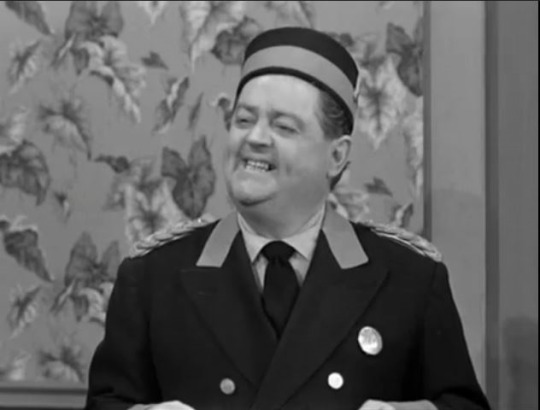
Bobby Jellison (Mr. Uh-Uh-Uh) will play the recurring character of Bobby the bellboy throughout the Hollywood episodes of “I Love Lucy”. Viewers may also remember him as the milkman in “The Gossip” (S1;E24). He makes one more appearance as another luggage jockey in “Lucy Hunts Uranium,” a 1958 episode of “The Lucy–Desi Comedy Hour”.
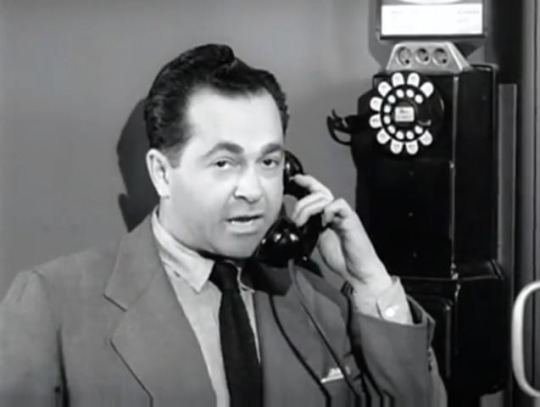
Jerry Hausner (Loan Store Clerk) was best known as Ricky Ricardo’s agent in “I Love Lucy” and as the voice of Waldo in “Mr. Magoo” and several characters such as Hemlock Holmes, The Mole, Broodles and Itchy in “The Dick Tracy Show.” On Broadway, Hausner had the role of Sammy Schmaltz in Queer People (1934). On radio, he was a regular on such shows as “Blondie”, “The Jim Backus Show”, “The Judy Canova Show”, “Too Many Cooks”, and “Young Love”. Hausner died of heart failure on April 1, 1993. He was 83 years old.
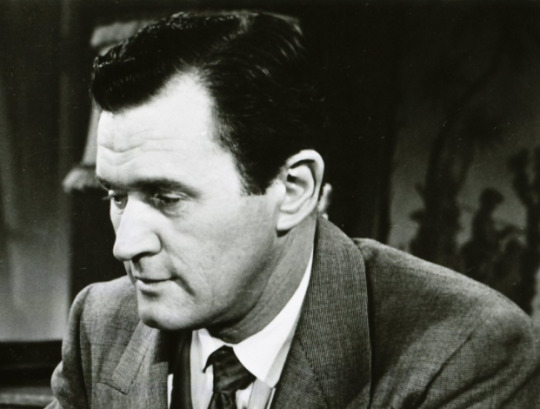
Wally Maher (Mr. Trimble, the Grocer) was born on August 4, 1908 in Cincinnati, Ohio. He was known for Mystery Street (1950), The Reformer and the Redhead (1950) and Hollywood Hotel (1937). He was heard with Lucille Ball in the Lux Radio Theatre version of “The Dark Corner” (1947), taking the role originated on film by William Bendix. He died on December 27, 1951.

Sandra Gould (Woman in Audience) is probably best remembered as the second actor to play Gladys Kravitz on “Bewitched” (1966-71). On “I Love Lucy,” she played Nancy Johnson in “Oil Wells” (ILL S3;E18) and makes a brief appearance as an alarmed strap-hanger in “Lucy and the Loving Cup” (ILL S6;E12). In 1962 she appeared in the fourth episode of “The Lucy Show” as a bank secretary.
EPISODE
ANNOUNCER: “As we look in on the Coopers this morning, they’re at breakfast, and from the way Liz is looking at George, she’s either madly in love or has some ulterior motive in mind.”
Liz wants to buy a new dress to wear to the club dance on Saturday, which costs $89.50. George won’t allow it but Liz is determined to get it by hook or by crook.
Later the doorbell rings and it is Iris Atterbury. A downbeat Liz tells Iris about the dress she wants. Iris is going to a radio broadcast and wants Liz to go along to cheer herself up - and possibly win enough money to buy the new dress.

The show is called “Everybody Wins” hosted by ‘Happy’ Hal Brubaker (Frank Nelson), a local radio game show. It is sponsored by Grandma Grimes Cold Cream. The first contestant is the woman with the reddest hair - Liz Cooper! Another woman in the audience (Sandra Gould) objects!
WOMAN: “Are you kiddin’ sister? At home, I’m a redhead. Next to you, I’m a brunette!”
Liz wins a $500 check just for stating her name. The catch is, Liz must cash the check in 25 minutes without telling anyone it is a stunt for a radio show. She’s assigned a man (Bobby Jellison) to watch her to be sure. Liz confesses that her husband is a banker. Brubaker reminds her that the show went on the air at 3pm when the banks close.

Liz and Iris tear out of the studio toward the bank. They bang on the door to get the guard’s attention. Liz sees George but can’t tell him why she needs to get in. Their watchdog chaperone intervenes with a warning “Uh uh uh!” every time Liz starts to explain. Mr. Atterbury comes by and Iris asks him to cash the check, but Mr. Atterbury says to come back in the morning. Liz pleads with him, but Mr. Atterbury cites state law. Liz stages a fake stick-up to get the cash. Mr. Atterbury points out that she hasn’t got a gun.
With twelve minutes left, Liz and Iris start out to look for somewhere else to cash the check.
End of Part One

Bob LeMond does a Jell-O commercial that gives a recipe for a quick dessert during the holidays.
ANNOUNCER: “As we look in on the Coopers again, Liz and Iris have just left the bank to try to find another place to cash the $500 check from ‘Everybody Wins’ which Liz can keep if she can cash it in the next 15 minutes. George and Mr. Atterbury have prepared to return to their work.”
At the bank, Mr. Atterbury and George are alone. He turns on the radio.
MR. ATTERBURY: “I wouldn’t want anyone to know that we go over the books with ‘Arthur Godfrey’”!

Arthur Godfrey (1903-83) was a tremendously popular host and entertainer. His CBS morning radio show “Arthur Godfrey Time” aired five times a week. He also had an evening program titled “Arthur Godfrey’s Talent Scouts” which soon transitioned to television. It was the lead-in to “I Love Lucy” in 1951 and promoted Godfrey did on-air promotion for “Lucy.” Many years later Godfrey guest-starred as himself on “The Lucy Show.” Although tremendously popular whenever he aired, Godfrey was noticeably absent from afternoons, so it is unlikely that George and Mr. Atterbury tune in to his program at 3pm.
When the radio comes on, however, it is tuned to “Everybody Wins”, not Arthur Godfrey.
HAPPY HAL BRUBAKER (over radio): “Thank you, Mrs. Malone for being such a good sport and jumping off the high ladder with an umbrella. You missed the mattress so you don’t get a prize. Thanks anyway, and we hope that little old leg of yours mends soon!”
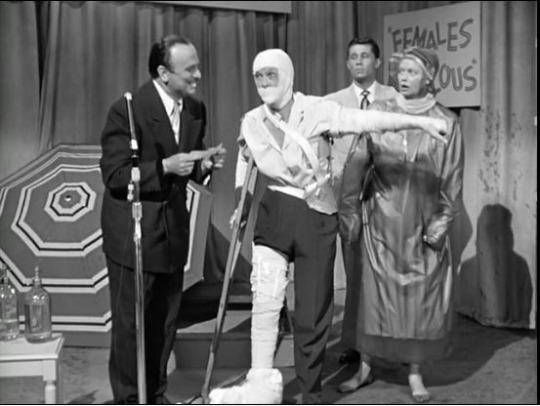
This verbal gag is brought vividly to life on television with the appearance of a heavily bandaged former winner Mrs. Peterson (Hazel Pierce) who went over Niagara Falls in a barrel!
George and Mr. Atterbury tune in just in time to hear Hal Brubaker report that Liz Cooper has not yet returned from cashing her check! They realize what all her secrecy was about and, after a brief disagreement, they fill their pockets with cash and race off to find her!

Liz and Iris see a loan shop sign “Do You Need Money? Hmmm?” in neon. The clerk (Jerry Hausner) tells them he will deduct the interest and the carrying charges giving her $14.32 with $50 weekly re-payments for 36 weeks! To get $500 they need to borrow $13,000!
They run out of the shop with only six minutes left. George and Mr. Atterbury spot them, but rather than explain and waste time, the girls duck into a taxi to go to Trimble’s Grocery, where Liz is sure Mr. Trimble will give her the cash.
Elderly grocer Mr. Trimble (Wally Maher) is in a chatty mood, wanting to talk about a mushy eggplant he sold her. He agrees to cash the check but is slow counting out the money from the cash drawer, making Liz a nervous wreck. He finally finishes, only to misread the check and count out $5.00 instead of five hundred!

Liz and Iris give up and go back to the radio station. Meanwhile, George and Mr. Atterbury give up chasing Liz and Iris and decide to go to the radio station. Liz arrives with a minute and a half to go. Defeated, she tears up the check just as the boys come racing in with the $500 cash. With 45 seconds to go they scramble to reassemble the check! Liz finds the final piece just as time expires.
Brubaker reveals that he tricked her. The “Uh Uh Uh” man had the money all the time and would have cashed the check had Liz just asked. George is outraged and punches Brubaker in his ‘Happy’ face! As a consolation, George agrees to give Liz the money anyway - plus $89.50 for the new dress.
LIZ: “Oh, George! You really are my favorite husband!”

In the final live Jell-O commercial, Lucille Ball takes on the character of a famous lady novelist and Bob LeMond is her interviewer. Lucy adopts a nasal voice as Elizabeth Dopplefinger Hopenshmice. The voice is similar to the one she will do as Isabella Clump in “The Million Dollar Idea” (ILL S3;E13). Elizabeth says she first imagines a book cover and then writes a story around it. Bob LeMond says he would like to see a bowl of Jell-O on the cover of a book, but Elizabeth prefers a more romantic cover and kisses him. LeMond still wants Jell-O on the cover.

Bob LeMond reads the credits. There is a recorded message from Instant Sanka.
END EPISODE
#My Favorite Husband#Lucille Ball#Bob LeMond#Gale Gordon#Bea Benadaret#Richard Denning#Radio#I Love Lucy#Frank Nelson#Wally Maher#Jerry Hausner#Sandra Gould#Bobby Jellison
2 notes
·
View notes
Text
AGATHA BARNES TIMELINE. {1918 - 2014}
November 21st 1918: Sergeant Alec McKinnon and Giovanna Bellini flee discrimination in Europe looking for a new life in America. The pair are expecting twins so hastily settle down in Brooklyn.
December 1st 1918: Elisa and Agatha McKinnon are born.
February 17th 1919: Giovanna returns to work in a local ward, with the help of neighbour Sarah Rogers, a kind woman who had recently lost her husband to the war and left with a newborn. The two grow a strong bond.
March 13th 1919: Agatha McKinnon and Steven Rogers meet for the first time.
October 26th 1923: Giovanna takes Agatha and her sister to their first gymnastics class in Queens.
June 30th 1925: Steve gets into a fight with some bullies at school, James Buchanan Barnes - a boy in the grade above - saves him.
July 4th 1925: Alec McKinnon takes his family to Coney Island, along with Steve for his 7th birthday to which he brings his new friend ‘Bucky’ Barnes who pulls his younger daughter’s pigtails and pokes at her rosy cheeks, he probably just likes her.
July 12th 1925: Agatha McKinnon pushes Bucky into a puddle after he kissed her because Steve said he should, well at least that’s what he told her.
July 24th 1926: Steve, Bucky and the McKinnon girls spend the hot summer day in the street having a water fight.
April 9th 1928: The trio visit Coney Island again, this time unsupervised.
They have an interesting day. First Steve vomited once off the Cyclone, Bucky spent all his money and Agatha accidentally stained ketchup on her pearl white dress. To get home they then had to hitch a ride on the back of a freezer truck.
May 7th 1931: Bucky and Agatha go on their first date of many at the theatre, despite her initial hesitance, it was actually a good time. They go see The Public Enemy starring James Cagney.
September 19th 1931: They become official, much to Steve’s joy and dismay.
August 14th 1934: The couple try and set Steve up with one Agatha’s friends, it goes about as well as you’d think leaving them stuck in the pouring rain after the girl had ran off.
August 29th 1934: Agatha becomes a regional champion gymnast.
December 18th 1934: Bucky and Agatha lose their virginity to each-other.
January 16th 1935: Steve gets into another fight, he manages to run from the bullies.
June 10th 1935: Bucky promises to get Agatha a ring once she’s done with school and they’ll get a big house in country and have twelve little babies running around.
February 23rd 1936: Agatha is offered a spot on the Olympic gymnastics team to compete later in the year. Her friends don’t want her to go, nor do her family. They’d heard the brutal stories of Germany’s narcotic leader, so she decides against it.
October 15th 1936: Sarah Rogers passes from Tuberculosis.
March 12th 1937: Bucky proposes to Agatha after going to see Snow White and the Seven Dwarfs.
December 6th 1937: The pair get married in a local church.
But prior to tying the knot, Bucky tells her about his plans to enlist in the army with her father and that he’d already been accepted; it takes Steve to make sure Agatha doesn’t smack him over the head once she reaches the end of the aisle. Elisa was sure she’d never seen a bride tearing-up before signing the papers.
December 20th 1937: Bucky leaves for Camp McCoy, Agatha refuses to see him off instead locking herself in their shared bedroom. Her father left the week prior, now promoted to Major General back in Scotland.
Time after time Steve attempted to get into the army only to be turned around, selfishly, Agatha was quite glad. She found out she was pregnant soon after and didn’t want to do it without having her best-friend by her side. Plus, as much as she knew Steve’s heart was there he’d be trampled the minute he arrived, with no Bucky.
August 27th 1938: Marie Ellen Barnes is born.
September 3rd 1939: Alec McKinnon is deployed onto the front-line as Britain announce war on Germany. Agatha and her sister have both started working for the local hospital, following in their mother’s footsteps.
January 6th 1941: Alec McKinnon is declared a Prisoner of War after losing to Japan in Singapore.
May 26th 1943: Bucky returns home for the first time in years before deploying to the UK.
He to sees his three-year-old daughter for the first - and final - time. The trio visit the Stark Expo and the usual banter ensues but when the couple arrive home Agatha makes it clear, once again how she feels about the war and warns Bucky to caution after what happened to her father and she doesn’t want to see him suffer the same fate to keep her content he leaves his dog-tags with her.
October 2nd 1943: Bucky becomes a Prisoner of War, unbeknown to Agatha who has been left alone once Steve managed to get into the army.
November 13th 1943: Steve saves Bucky as Captain America, they return to camp.
February 22nd 1945: Bucky Barnes is pronounced dead, Steve lets her know over the phone.
March 1st 1945: The Winter-Solider Program begins.
April 16th 1945: Armin Zola locates a distraught Agatha Barnes after beating it out of Bucky when he refused to cooperate.
April 19th 1945: HYDRA capture Agatha on the street and begin using her to force Bucky back into the brainwashed state, using her screams as a clear trigger. When he heard it, it would force his brain to forget and they’d stop hurting her. As the years went by he did just forget why it would alter him because he hadn’t ever seen Agatha since 1943.
By 1955 HYDRA had managed to keep Bucky’s psyche under-control meaning there was no longer need for Agatha so, instead of risking a breach they shoved her into a cryogenic freezer except this time it wouldn’t be re-opened, leaving her trapped in the body of a twenty-six-year-old.
During this period, some of the bacteria left in her scars fused with what HYDRA had been injecting her with so with the combination of the ice was able link with her body without her knowledge - this gave her, her freeze-power.
September 4th 1945: Alec McKinnon returns home from a war-camp in Japan with three fingers chopped off and the loss of sight in an eye. Only to find one of his children missing, and her daughter being looked after by his other daughter.
November 17th 1970: Giovanna Bellini passes from lung cancer.
July 31st 1972: Alec McKinnon passes from natural causes.
March 28th 1996: Elisa McKinnon passes from lung cancer.
November 1st 2010: On a simple recon mission agent Natasha Romanoff locates a living being in a freezer beneath a supposedly abandoned warehouse, she reports back to Nick Fury. Once out of the tube, their only form of identification; the dog-tags that hung from her neck reading Sgt. J. B. Barnes.
November 4th 2010: Agatha Barnes is freed for the first in 55 years.
November 10th 2010: There is a freak accident in the Shield headquarters after Agatha has a panic-attack in her new, modern surroundings. She’d created a catalyst of smashed windows cause by a mixture of a sudden temperature drop and sharp icicles.
December 23rd 2010: Once safely relocated Agatha back in Brooklyn, she begun actively looking for what remained of her family, including her daughter.
March 5th 2011: Agatha is finally reunited with Marie, as well as her grandchildren and some great-grandchildren, they devise a plan so Agatha can act as their aunt - rather than an ninety-two-year-old great-grandmother that didn’t look a day over 30.
October 4th 2011: Steve Rodger’s body is found.
October 26th 2011: Agatha and Steve meet again, they tell each-other conflicted stories about Bucky, though both presume he is dead. Agatha believing HYDRA killed him - that’s why they disposed of her and Steve is positive he watched him fall to his death.
January 19th 2012: Agatha is approached by Nick Fury about the Avengers-Initiative. She sternly declines not interested in harnessing her powers and wants to make-up for lost time with her family, despite his protests he eventually gets the message.
April 22nd 2012: HYDRA agents hidden amongst SHIELD ambush Agatha in her home with the intent of recapture, they all end up dead after she has a mental snap.
July 24th 2013: Steve has a go himself trying to get Agatha to better her powers for the greater good, telling her how proud it would make Bucky.
January 10th 2014: Now in full control, Agatha joins Steve, Natasha and Sam Wilson in order to find out who is after Fury.
January 11th 2014: The Battle of Washington. After Natasha has been compromised, Agatha stepped in to fight the masked-man whilst Steve was preoccupied. It was the first she’d be properly pushed harm but after some bad footing, she was down and at wrong end of a handgun. Thankfully Steve’s shield knocked him off her. Once rejoining the fight the two play essentially a tag-team, one out, one in. Then, the mask came off. She genuinely believed her heart stopped.
January 15th 2014: Steve and Agatha begin their search for the Winter Soldier.
3 notes
·
View notes
Text
Mustafa Kemal Atatürk (1881 – 1938) was the founder and the first President of the Republic of Turkey. Mustafa Kemal was born in 1881 in Salonika (Thessaloniki, today in Greece, then under the Ottoman rule). His father’s name was Ali Riza Efendi. His father was customs official.
His mother’s name was Zübeyde Hanim. For his primary education, he went to the school of Semsi Efendi in Salonika. But Mustafa lost his father at an early age, he had to leave school. Mustafa and his mother went to live with his uncle in the countryside. His mother brought him up. Life continued like this for a time. Mustafa worked on the farm but his mother began to worry about his lack of schooling. It was finally decided that he should live with his mother’s sister in Salonika.
He entered the Military Middle School in Salonika. In 1895, after finishing the Military Middle School, Mustafa Kemal entered the Military High School (Askeri Idadisi) in Manastir.
After successfully completing his studies at the Manastir Military School, Mustafa Kemal went to Istanbul and on the 13th of March 1899 he entered the infantry class of the Military Academy (Harbiye Harp Okulu). After finishing the Military Academy, Mustafa Kemal went on to the General Staff College in 1902. He was graduated from the Academy with the rank of captain on the 11th of January, 1905.
In 1906, he was sent to Damascus (Sam). Mustafa Kemal and his friends founded a society which they called “Vatan ve Hürriyet” (Fatherland and Freedom) in Damascus. On his own initiative, he went to Tripoli during the war with Italy in 1911 and took part in the defense of Derne and Tobruk. While he was still in Libya, the Balkan War broke out. He served in the Balkan War as a successful Commander (1912-1914). At the end of the Balkan War, Mustafa Kemal was appointed military attaché in Sofia.
When Mustafa Kemal was in Sofia, the First World War broke out. He was made Commander of the Anafartalar Group on 8th of August, 1915. In the First World War he was in command of the Turkish forces at Anafartalar at a critical moment. This was when the Allied landings in the Dardanelles (Canakkale Bogazi) took place and he personally saved the situation in Gallipoli. During the battle, Mustafa Kemal was hit by shrapnel above the heart, but a watch in his breast pocket saved his life. Mustafa Kemal explained his state of mind as he accepted this great responsibility: “Indeed, it was not easy to shoulder such responsibility, but as I had decided not to live to see my country’s destruction, I accepted it proudly”. He then served in the Caucasus and in Syria and just before the armistice in 1918 he was placed in command of the Lightning Army group in Syria. After the armistice (peace agreement), he returned to Istanbul.
After the Armistice of Montreux, the countries that had signed the agreement did not consider it necessary to abide by its terms. Under various pretexts the navies and the armies of the Entente (France, Britain and Italy) were in Istanbul, while the province of Adana had been occupied by the French, and Urfa and Maras by the British. There were Italian soldiers in Antalya and Konya, and British soldiers in Merzifon and Samsun. There were foreign officers, officials and agents almost everywhere in the country.
On the 15th of May 1919 the Greek Army landed in Izmir with the agreement of the Entente. Under difficult conditions, Mustafa Kemal decided to go to Anatolia. On 16th of May 1919, he left Istanbul in a small boat called the “Bandirma”. Mustafa Kemal was warned that his enemies had planned to sink his ship on the way out, but he was not afraid and on Monday19th May 1919, he arrived in Samsun and set foot on Anatolian soil. That date marks the beginning of the Turkish War of Independence. It is also the date that Mustafa Kemal later chose as his own birthday. A wave of national resistance arose in Anatolia. A movement had already begun in Erzurum in the east and Mustafa Kemal quickly placed himself at the head of the whole organization. The congresses in Erzurum and Sivas in the Summer of 1919 declared the national aims by a national pact.
When the foreign armies occupied Istanbul, on 23rd of April 1920 Mustafa Kemal opened the Turkish Grand National Assembly and hence established a provisional new government, the centre of which was to be Ankara. On the same day Mustafa Kemal was elected President of the Grand National Assembly. The Greeks, profiting by the rebellion of Cerkez Ethem and acting in collaboration with him, started to advance towards Bursa and Eskisehir. On the 10th of January 1921, the enemy forces were heavily defeated by the Commander of the Western Front, colonel Ismet and his troops. On the 10th of July 1921, the Greeks launched a frontal attack with five divisions on Sakarya. After the great battle of Sakarya, which continued without interruption from the 23rd of August to the 13th of September, the Greek Army was defeated and had to retreat. After the battle, the Grand National Assembly gave Mustafa Kemal the titles of Ghazi and Marshal. Mustafa Kemal decided to drive the enemies out of his country and he gave the order that the attack should be launched on the morning of the 26th of August 1922. The bulk of the enemy forces were surrounded and killed or captured on the 30th of August at Dumlupinar.
The enemy Commander-in-Chief, General Trikupis, was captured. Or the 9th of September 1922 the fleeing enemy forces were driven into the sea near Izmir. The Turkish forces, under the extraordinary military skills of Kemal Atatürk, fought a War of Independence against the occupying Allied powers and won victories on every front all over the country.
On the 24th of July 1923, with the signing of the Treaty of Lausanne, the independence of the new Turkish State was recognized by all countries. Mustafa Kemal built up a new, sturdy, vigorous state. On the 29th of October 1923, he declared the new Turkish Republic. Following the declaration of the Republic he started to his radical reforms to modernize the country. Mustafa Kemal was elected the first President of the Republic of Turkey.
Atatürk made frequent tours of the country. While visiting Gemlik and Bursa, Atatürk caught a chill. He returned to Istanbul to be treated and to rest, but, unfortunately Atatürk was seriously ill. He spent his last days of life on the presidential yacht of Savarona. At 9.05 AM on the 10th of November 1938, Atatürk died, but he attained immortality in the eyes of his people. Since the moment of his death, his beloved name and memory have been engraved on the hearts of his people. As a commander he had been the victorious of many battles, as a leader he had influenced the masses, as a statesman he had led a successful administration, and as a revolutionary he had striven to alter the social, cultural, economic, political and legal structure of society at its roots. He was one of the most eminent personalities in the history of the world, history will count him among the most glorious sons of the Turkish nation and one of the greatest leaders of mankind.
1 note
·
View note
Photo

Claudia Cardinale (born April 15th, 1938) in London, c. 1960 Check this blog!
37 notes
·
View notes